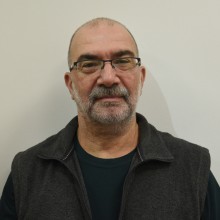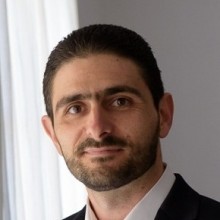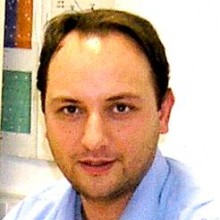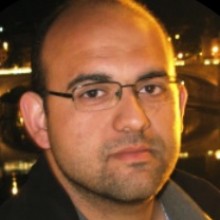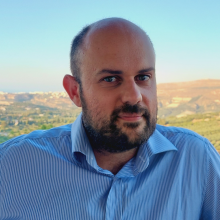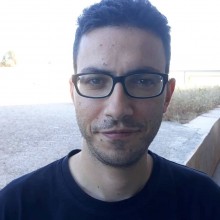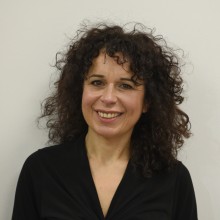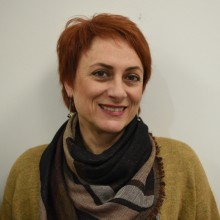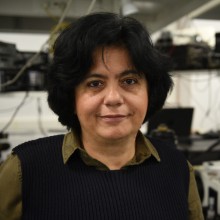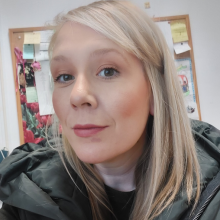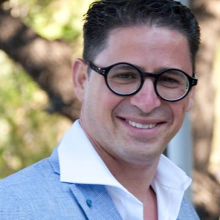Position Description
The Institute of Electronic Structure and Laser of the Foundation for research and Technology Hellas (IESL -FORTH), in the framework of the project CO2toO2 of Sub-Action 2, TΑ1 "Natural Sciences, Engineering Sciences and Technology, Environment and Energy" of the Proclamation "Funding of Basic Research (Horizontal support of all Sciences), National Recovery and Resilience Plan (Greece 2.0), funded by the Hellenic Foundation for Research and Innovation (HFRI) and the General Secretariat for Research and Technology (GSRT) under Grant CO2toO2 Nr.:015922, is seeking to recruit one PhD student. Experimental Atomic, Molecular and Optical physics, with emphasis in light engineering/detection/characterization and data analysis/processing.
Required Qualifications
- Bachelor’s and Master’s degree in physics
- Research experience in laser technology, photon detection and characterization, data analysis/processing, light interaction with atomic ensembles
Desirable Qualifications
- Scientific publications relevant to the position description
- Computational skills (Python, Matlab, Mathematica)
Application Procedure
Interested candidates who meet the aforementioned requirements are kindly asked to submit their applications to the address (hr@iesl.forth.gr), with cc to the Scientific Responsible, Dr P. Tzallas (ptzallas@iesl.forth.gr).
In order to be considered, the application must include:
- Application Form (Form Greek or Form English to the left)
- Detailed curriculum vitae (CV) of the candidate
- Scanned Copies of academic titles
- Recent certificate of enrollment in a PhD program
Appointment Duration
6Position Description
Ο/Η επιλαχών/ούσα βοηθός έρευνας θα απασχοληθεί με την ανάπτυξη και τον χαρακτηρισμό καταλυτικών υλικών
Related Project
CATSOLHYDROGEN -Required Qualifications
- Πτυχίο Φυσικής
- Εργαστηριακή Εμπειρία στην Ανάπτυξη Υλικών
- Εργαστηριακή Εμπειρία στον Χαρακτηρισμό Υλικών
Desirable Qualifications
- Εμπειρία σε τεχνικές περίθλασης ακτίνων Χ και μικροσκοπίας
Application Procedure
Interested candidates who meet the aforementioned requirements are kindly asked to submit theirapplications to the address (hr@iesl.forth.gr), with cc to the Scientific Responsible, Prof. V. Binas (binas@iesl.forth.gr).
In order to be considered, the application must include:
- Application Form (Form Greek or Form English to the left)
- Detailed curriculum vitae (CV) of the candidate
- Scanned Copies of academic titles
Appointment Duration
5Funding

Position Description
The Institute of Electronic Structure and Laser of the Foundation for research and Technology
Hellas (IESL -FORTH), in the framework of the project MULTICOOL(Hybrid, multifunctional cooling metamaterials for next-generation high-efficiency solar cells) is seeking to recruit one (1) PhD candidate position. The PhD student will investigate, both via first princiles numerical simulations and experimental spectroscopic approaches, the optical properties of certain materials as to identify materials for radiative cooling and solar cell applications.
Required Qualifications
- Bachelor in Materials Science
- Master in Engineering
- Good knowledge of English
Desirable Qualifications
- Knowlwdge of Python
- Knowledge of spectroscopic methods
Application Procedure
Interested candidates who meet the aforementioned requirements are kindly asked to submit their applications to the address (hr@iesl.forth.gr), with cc to the Scientific Responsible, Prof. Kafesaki Maria ( kafesaki@iesl.forth.gr ).
In order to be considered, the application must include:
- Application Form (Form Greek or Form English to the left)
- Detailed curriculum vitae (CV) of the candidate
- Scanned Copies of academic titles
Appointment Duration
4Abstract
Το Ινστιτούτο Ηλεκτρονικής Δομής και Λέιζερ του Ιδρύματος Τεχνολογίας και Έρευνας (ΙΤΕ-ΙΗΔΛ) στο πλαίσιο του έργου «APECS-PL-PN:101183307», προτίθεται να προχωρήσει στην επισκεύη-συντήρηση του ευθυγραμμιστή μασκών οπτικής λιθογραφίας (Mask aligner)».
Technical Characteristics
Procedure
Contact Persons
To: 29/05/2025 14:00
A key factor in current approaches for tissue and organ regeneration relies on enhancing (stem) cell-material interactions to obtain the same original functionality. Different approaches include delivery of biological factors, functionalization of biological factors onto 3D scaffolds surface, engineering surface properties (e.g. via topography modifications), and controlling bulk and structural chemical and mechanical properties of the cell-laden biomaterial porous constructs that are developed for regeneration. Although these strategies have proved to augment cell activity on biomaterials, they are still characterized by limited control in space and time, which hampers the proper regeneration of complex tissues. Here, we present a few examples where integration of biofabrication platforms allowed the generation of a new library of biological constructs with tailored biological, physicochemical, and mechanical cues at the macro, micro, and nano scale. These biological constructs are characterized by tailored cell-material interactions able to influence the activity of stem cells, thereby sustaining the regeneration of complex tissues. From these examples as well as from the study of other scientists, converging technologies seems to be a powerful route towards designing of biological constructs with instructive properties able to control cell activity for the regeneration of functional tissues. Future efforts should aim at further improving technology integration to achieve a fine control on stem cell fate by biomaterial and scaffolds design at multiple scales. This will enable the regeneration of complex tissues including vasculature and innervation, which will result in enhanced in vivo integration with surrounding tissues. By doing so, the gap from tissue to organ regeneration will be reduced, bringing regenerative medicine technologies closer to the clinics.
Position Description
Job Description
Technical support for the design and construction of a beam splitter board
We are looking for a Research Assistant to take an important role in our ESA projects in space optics. The ideal candidate should be able to work indecently as well as in a team
Required Qualifications
- B.Sc. Degree in Materials Science or related domains.
- M.Sc. Degree in Materials Science or related domains
Desirable Qualifications
- Demonstrated Experience in designing and implementing optical systems
- Fluent in English, both written and spoken (at least C2)
-
Interview
Application Procedure
Interested candidates who meet the aforementioned requirements are kindly asked to submit their applications to the address (hr@iesl.forth.gr), with cc to the Scientific Coordinator Dr Wolf von Klitzing (wvk@iesl.forth.gr).
In order to be considered, the application must include:
- Application Form (Form Greek or Form English to the left)
- Brief CV
- Scanned copies of academic titles
Any application received after the deadline will not be considered for the selection
Appointment Duration
12Position Description
Μία Θέση Μεταδιδάκτορα στο Εργαστήριο Ηλεκτρονικών Πολυμερών και Βιοηλεκτρονικής : Χαρακτηρισμός οργανικών αγώγιμων μορίων και πολυμερών για την ανάπτυξη ηλεκτρονικού δέρματος
Αναζητούμε έναν/μια μεταδιδάκτορα για να μελετήσει νέα πολυμερικά υλικά, με εφαρμογή στην ανάπτυξη ηλεκτρονικού δέρματος, σε ερευνητικό έργο χρηματοδοτούμενο από το ΕΛΙΔΕΚ. Συγκεκριμένα το άτομο που θα επιλεγεί θα δουλέψει πάνω στην επεξεργασία και στο φυσικό χαρακτηρισμό οργανικών αγώγιμων πολυμερών. Έμφαση θα δοθεί στο χαρακτηρισμό των οπτικών και οπτοηλεκτρονικών ιδιοτήτων των υλικών αυτών. Πρότερη εμπειρία στην κατασκευή custom διατάξεων για το χαρακτηρισμό δειγμάτων θα εκτιμηθεί ιδιαιτέρως θετικά
Related Project
Pol-eSkin -Required Qualifications
- Πτυχίο και μεταπτυχιακό στη Φυσική
- Διδακτορικό Δίπλωμα στη Φυσική
- Άριστη γνώση και χρήση της αγγλικής γλώσσας
- Πρότερη εργαστηριακή εμπειρία (10+ έτη) σε φασματοσκοπικές μεθόδους για τη μελέτη οπτικών και οπροηλεκτρονικών ιδιοτήτων λεπτών υμενίων ή μεμβρανών.
Desirable Qualifications
- Εμπειρία στον αυτοματισμό εργαστηρίου για την κατασκευή custom διατάξεων για τον αυτοματοποιημένο χαρακτηρισμό δειγμάτων
Application Procedure
Στο φάκελο υποβολής της πρότασης θα πρέπει να εμπεριέχονται τα ακόλουθα:
- Αίτηση (Form Greek στην αριστερή στήλη) με αναφορά στο όνομα του προγράμματος
- Αναλυτικό Βιογραφικό Σημείωμα
- Ευκρινή φωτοαντίγραφα τίτλων σπουδών
ΥΠΟΒΟΛΗ ΠΡΟΤΑΣΕΩΝ
Οι ενδιαφερόμενοι καλούνται να υποβάλουν τις αιτήσεις τους και όλα τα απαραίτητα δικαιολογητικά, ηλεκτρονικά στη διεύθυνση hr@iesl.forth.gr με κοινοποίηση (cc): στην Δρ Ε. Παυλοπούλου (epavlopoulou@iesl.forth.gr). Οι αιτήσεις θα πρέπει να αποσταλούν με την ένδειξη: «Αίτηση στο πλαίσιο του προγράμματος Pol-eSkin, της πρόσκλησης εκδήλωσης ενδιαφέροντος με Α.Π. … ».
Appointment Duration
4The solar infrared (IR) spectrum has crucial applications in electronic systems, such as reducing the weight and launch costs of satellite solar cells. However, its potential remains underutilised. The EU-funded POWERSAT project aims to develop a platform that captures energy from the IR spectrum and converts microwave spillover from satellite antennas into a DC power supply. This energy will power low-power embedded electronics within satellites and enable efficient inter-satellite communication links. The project will produce five demonstrators: one for solar energy harvesting and four for capturing microwave energy. The goal is to integrate these technologies into satellite electronic systems, replacing traditional solar cells and thereby reducing satellite weight and launch costs.
Principal Investigator
Scientific Staff
Technical Staff
Alumni
Funding



